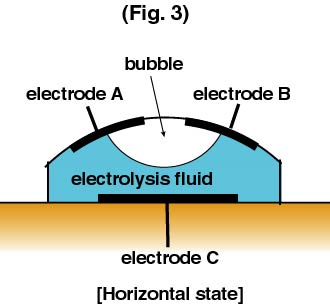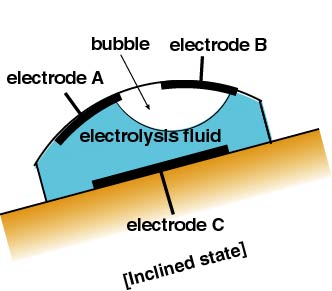  Top of Part 4
Top of Part 4
  Previous p.
Previous p.
  Next page
Next page
|
 Tilt measurement Tilt measurement
 is to measure is to measure
 changes in the tilt of changes in the tilt of
 the Earth' surface, the Earth' surface,
 which is one of which is one of
 methods to know methods to know
 the ground deformation. the ground deformation.

 We are now able We are now able
 to detect very to detect very
 slight changes in slight changes in
 the ground tilt of the volcano. the ground tilt of the volcano.
 Our highly sensitive Our highly sensitive
 bubble-tube tiltmeter bubble-tube tiltmeter
 is so small is so small
 in size that it is in size that it is
 very suitable for the very suitable for the
 filed observations. filed observations.

 We put tiltmeters around We put tiltmeters around
 the Fugendake crater and the Fugendake crater and
 succeeded in obtaining succeeded in obtaining
 signs indicating repetitive rise signs indicating repetitive rise
 of magma mass of magma mass
 through the vent to the through the vent to the
 crater (see Fig. 1). crater (see Fig. 1).

 We also observed We also observed
 how the pressure changed how the pressure changed
 inside the volcano during inside the volcano during
 explosions (see Fig. 2). explosions (see Fig. 2).

 Furthermore, based Furthermore, based
 on tiltmeter data, on tiltmeter data,
 we succeeded in continuous we succeeded in continuous
 estimation of the magma volume estimation of the magma volume
 supplied to the crater. supplied to the crater.
 This enabled us to This enabled us to
 get immediate grasp get immediate grasp
 of activity levels of of activity levels of
 the volcano. the volcano.

|

 Top of Part 4
Top of Part 4

 Previous p.
Previous p.

 Next page
Next page
 Tilt measurement
Tilt measurement
 is to measure
is to measure
 changes in the tilt of
changes in the tilt of
 the Earth' surface,
the Earth' surface,
 which is one of
which is one of
 methods to know
methods to know
 the ground deformation.
the ground deformation.

 We are now able
We are now able
 to detect very
to detect very
 slight changes in
slight changes in
 the ground tilt of the volcano.
the ground tilt of the volcano.
 Our highly sensitive
Our highly sensitive
 bubble-tube tiltmeter
bubble-tube tiltmeter
 is so small
is so small
 in size that it is
in size that it is
 very suitable for the
very suitable for the
 filed observations.
filed observations.

 We put tiltmeters around
We put tiltmeters around
 the Fugendake crater and
the Fugendake crater and
 succeeded in obtaining
succeeded in obtaining
 signs indicating repetitive rise
signs indicating repetitive rise
 of magma mass
of magma mass
 through the vent to the
through the vent to the
 crater (see Fig. 1).
crater (see Fig. 1).

 We also observed
We also observed
 how the pressure changed
how the pressure changed
 inside the volcano during
inside the volcano during
 explosions (see Fig. 2).
explosions (see Fig. 2).

 Furthermore, based
Furthermore, based
 on tiltmeter data,
on tiltmeter data,
 we succeeded in continuous
we succeeded in continuous
 estimation of the magma volume
estimation of the magma volume
 supplied to the crater.
supplied to the crater.
 This enabled us to
This enabled us to
 get immediate grasp
get immediate grasp
 of activity levels of
of activity levels of
 the volcano.
the volcano.

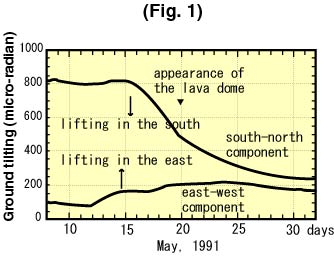
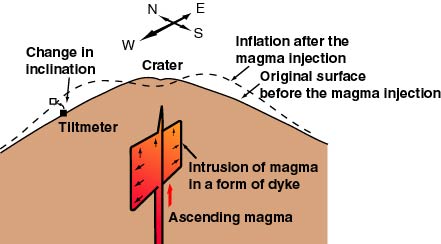
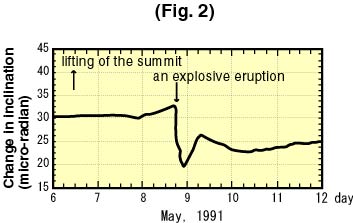
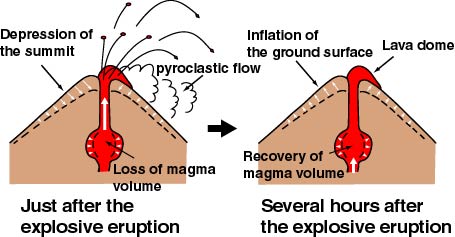

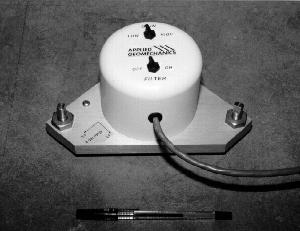 The cylindrical cover: 10 cm in diameter.
The cylindrical cover: 10 cm in diameter.
